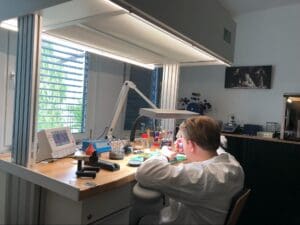In today’s hectic fast-paced world, where most things are built simply for convenience and speed, it’s quite easy to forget the value of patience, precision and hands-on craftsmanship.
That’s exactly why mechanical watches continue to hold a special place in the hearts of collectors and casual shoppers alike. Today, we are going to take a closer look at the watchmaking process of Tufina Watches – a brand whose core principles are hand-assembly and pure craftsmanship. Let’s get started.
It Starts with Heritage
Craftsmanship isn’t just about using the right tools and techniques. A brand must have its own history. For Tufina, that history runs deep. A family-owned independent brand with roots in watchmaking that date back to the 1800s. Their earliest timepieces actually included tower clocks, pocket watches, table clocks and early mechanical compositions.
Over generations, their techniques and knowledge were passed down, just like a family heirloom. Each generated added something new while preserving what mattered most – a passion for the art of watchmaking.
This long-standing tradition shapes how Tufina watches are built today. Their collections reflect a sense of continuity, honoring their history, drawing inspiration from past design elements, while creating something fresh, modern and wearable.
Inside the Hand Assembly Process: The Casablanca Theorema
We were able to observe the production process of the Casablanca Theorema up close. Seeing the assembly work in detail provided valuable insight into the level of craftsmanship involved. Let’s walk you through what goes into assembling this timepiece.
1. The Mechanical Movement
Casablanca is a mechanical hand wind watch. Its movement is fitted with 17 rubies. Now, these jewels aren’t decorative (although they look fantastic thanks to the open front and back design). However, they’re functional bearings used at specific high-friction points in the gear train and escapement.
Their purpose is to reduce wear, prevent metal-on-metal contact and ensure the movement operates accurately even with consistent use.
Each ruby is set into the base plate using a special jeweling press. Then, the watchmaker will assemble the gear train, the escapement, the balance wheel and the barrel. This part involves a multi-stage process that is quite demanding, as it requires incredible precision.
Think about this: even the smallest errors, such as misaligning pivots or over-tightening the screws, can affect timekeeping, or worse, damage the mechanism entirely.
After full manual assembly, the movement is tested to evaluate factors such as beat accuracy, amplitude and positional deviation. This is done using a timegrapher. Any discrepancy is immediately corrected through manual and extremely delicate adjustments to the regulator.
2. Skeletonized Dial and Sub-Seconds Indicator
Unlike traditional dials, the Casablanca features an open-worked skeleton design. The skeletonization process allows watchmakers to showcase the movement from both front and back. However, this technique requires additional precision in finishing each component since nothing is hidden.
Then, they fit the sub-dial at 6 o’clock, which is used for the seconds indicator. This part connects directly to the fourth wheel of the movement and it requires proper and careful calibration to reflect accurate timing.
3. Luminous Hands and Dial Placement
The job is far from over. The hands, which in this case are photoluminescent, are carefully mounted using specialized tools. Here, the watchmakers apply just enough pressure to precisely press them into place on their respective pinions without scratching or bending them.
Then, the watchmakers will double-check the alignment and clearance of the hour and minute hands, ensuring none of them touch each other (which would hinder their movement over the dial) or the skeletonized dial itself.
4. IPG Gold-Plated Case and Sapphire-Coated Lens
Now, it’s time to bring the movement home. The fully assembled movement is placed inside a 5-micron, 22 karat gold IPG-plated stainless steel case. Ion Plating is a popular technique used in luxury watchmaking. The use of 22 karat gold ensures both a fantastic luster and shine, but also resistance to fading even with regular wear.
The sapphire-coated lens is fitted next. This material offers amazing scratch resistance while maintaining a clear view of the mechanical design. Both the front and the back of the case are open, with the rear crystal allowing the wearer to take a look at the oscillating balance wheel and gear train.
5. Leather Strap and Butterfly Buckle
Next, the brown leather strap is hand-fitted to the case. The leather is embossed with an alligator-style pattern. It adds style, but more than that, the material itself is comfortable on the wrist. Then, the butterfly buckle is installed and tested for even deployment and secure closure.
6. Final Quality Control
Now, it’s time for Casablanca to be placed through a final inspection phase. This stage includes several steps, such as:
Movement timing checks in multiple positions
Verifying luminous function in low light
Pressure testing the case seals
Other aesthetic checks for details regarding the polishing, plating and crystal clarity
To ensure its 3ATM water resistance, the watchmakers also perform a case-sealing test. They use a device called the Leak Checker Prime. This specialized precision instrument uses controlled air pressure to precisely detect leaks in the case and crown. All is done without exposing the watch to actual water.
So, by monitoring how the watch reacts to pressure changes inside a fully sealed chamber, the device will confirm whether the watch meets its designated 3 ATM water resistance specification.
This is a crucial step, as it ensures the watch will be resistant to long-term damage from moisture intrusion.
Only after passing all these quality checks is the Casablanca packaged and shipped.
Designs That Reflect the Inner Workings
The aesthetic of Tufina watches is driven by the same philosophy behind their engineering: transparency, beauty and intention. This is also one of the reasons why so many of their models feature skeletonized dials or even open-heart designs, because they want you to see and appreciate the movement inside.
So, it’s not just for looks, although these designs are undeniably eye-catching. Their work revolves around putting the Tufina watches craftsmanship on full display.
Final Thought: Why Craftsmanship Still Matters
In today’s culture, where convenient disposable items are often more popular than most, valuing true craftsmanship seems like a quiet rebellion. If you appreciate quality over quantity, substance over speed and meaning over mass production and fast-fashion, we believe exploring a Tufina watch would open your eyes to new horizons.
That’s why so many brands like Tufina continue to earn loyal followings from people who want more. Because in the end, craftsmanship still matters, and it always will.
Read more:
Craftsmanship Matters: Inside the Making of Tufina Watches









